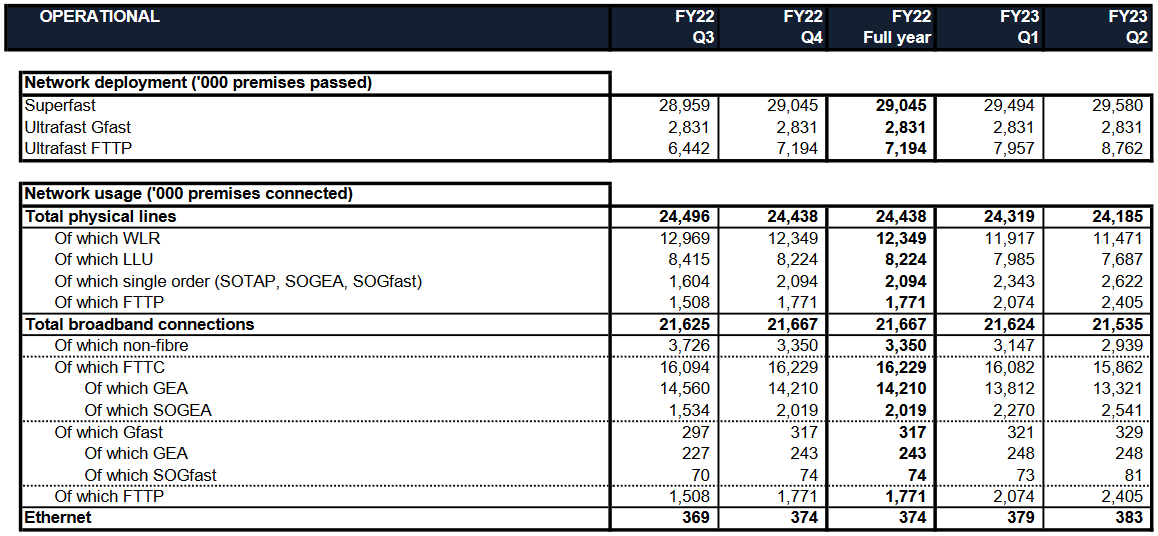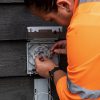BT Results See FTTP Broadband Cover 8.8 Million UK Premises

The latest Q2 FY23 results to September 2022 have today been released by the BT Group, which saw the coverage of Openreach’s Fibre-to-the-Premises (FTTP) broadband ISP network reach 8.76 million premises (up by 805k in the quarter vs 763k last quarter). Meanwhile, EE’s 5G customers topped 8.157 million (up from 7.74m).
Easily the biggest news this quarter has undoubtably been the ongoing strike action by tens of thousands of the operator’s employees (here), which has continued through October and is slowly becoming more disruptive. In other news, BT is taking Virgin Media (VMO2) to court in a dispute over EE MVNO mobile migrations (here) and the government has dropped a security probe into Alice UK’s stake in the operator (here).
On top of all that, Openreach are preparing to test faster broadband tiers – 1.2Gbps and 1.8Gbps – on their FTTP broadband network (here) and BT’s sub-brand, Plusnet, has closed its manage broadband service with John Lewis to new customers (here) – the writing may also be on the wall for Plusnet’s own business products.
Advertisement
Financial Highlights – BT’s Quarterly Change
* BT Group revenue = £5,151m (up from £4,979m)
* BT Group total net debt = £19,042m (increased from £18,891m)
BT’s (EE) consumer division does not publish full customer figures for their own retail broadband ISP, but they do report data for their “ultrafast” (100Mbps+) packages and mobile service. The consumer ISP stated that they had 1.404 million FTTP customers (up from 1.283m last quarter) and EE’s “5G Ready” base now stands at 8.157 million (up from 7,737m).
Meanwhile, some 78.2% of BT’s fixed consumer base take a “superfast broadband” product (down from 79.3% last quarter) and 12.9% (up from 11.5%) have adopted one of for their “ultrafast broadband” products – including both G.fast and FTTP. We also noted that 21.7% of BT’s customers are now taking both mobile and broadband (converged) – down slightly from 21.8%.
Openreach’s Network
The table below offers a breakdown of fixed line network coverage and take-up by technology on Openreach’s UK network, which covers the totals for all ISPs that take their products combined (e.g. BT, Sky Broadband, TalkTalk, Zen Internet, Vodafone etc.).

Advertisement
The rollout of full fibre (FTTP) lines continues to grow, with 805,000 premises being added in the quarter (up from 763,000 last quarter). As for take-up, some 2.405 million FTTP broadband connections have been made on Openreach’s network (up from 2.074m), which equates to a take-up of 27.45% (up from 26.05% last quarter).
The rapid rollout of a new network almost always tends to suppress the take-up figure, thus Openreach is doing extremely well to buck that trend with their FTTP build. All of this is despite the increasingly significant amount of rising competition from a mass of alternative full fibre networks.
Philip Jansen, CEO of BT Group, said:
“BT Group remains on the front foot in these turbulent times. Our strategy is working, we’re executing against our plan and we’re confident that we’ll deliver our long-term ambition while underpinning economic growth in the UK.
Our financial performance is on track; we grew revenue and EBITDA in the first six months of the year and we remain laser focused on modernising and simplifying BT Group. Given the current high inflationary environment, including significantly increased energy prices, we need to take additional action on our costs to maintain the cash flow needed to support our network investments. As a result, we are increasing our cost savings target from £2.5bn to £3.0bn by the end of FY25.
High-quality connectivity has never been more important for our customers and our products provide great value for money.
We continue to drive ahead with our strategy designed to deliver consistent and predictable revenue and EBITDA growth, expand cash flow and underpin our progressive dividend policy over the longer-term.”
The results also contain a few other little bits of interesting information. For example, over 62% of FTTP orders in Q2 were for ultrafast speeds and 54% of all FTTP orders were from ISPs external to BT Group (e.g. Sky Broadband, TalkTalk etc.). The operator’s FTTP footprint is also up over 50% year on year, now passing 8.8m homes and businesses (inc. 2.8m premises in rural locations), with a further 6m where initial build is underway.
The group also received a tax refund of c.£0.2bn in October and have decided to reinvest this back into their fibre build, meaning that they are raising their capex outlook for this year from c.£4.8bn to c.£5.0bn, with the increase due to fibre connections ahead of expectations and inflation.
Advertisement
Mark is a professional technology writer, IT consultant and computer engineer from Dorset (England), he also founded ISPreview in 1999 and enjoys analysing the latest telecoms and broadband developments. Find me on X (Twitter), Mastodon, Facebook, BlueSky, Threads.net and Linkedin.
« FullFibre Ltd’s Network in Derbyshire Gets 100G Capacity Boost






















































So is 25 million premises by 2026 achievable? What’s that 4 years.
Not really, certainly not with current industrial relations.
Four and a quarter years (since these figures are for end Sep 2022).
To achieve this, their build rate would have to increase from 805K per quarter to 955K per quarter. It’s not impossible, although presumably as the rollout continues, they will have to start attacking some of the more difficult areas, and return to fill in areas which were problematic first time round.
“It’s not impossible, although presumably as the rollout continues, they will have to start attacking some of the more difficult areas”
Actually, as far as I can tell, BT have been avoiding building out many easy areas. From what I’ve read in various articles listing Altnet builds, CityFibre and others appear to have a free pass to overbuild VMO2 franchise areas, while Openreach haven’t even included many such areas in their build plans. As an example, I live in Bolton and VM have served customers in Astley Bridge, Hall i’ th’ Wood and much of the surrounding areas for many years, now being overbuilt by CityFibre; The areas are well served by Openreach managed ducting, going off the number of BT manhole covers populating the area, yet Openreach seem to have no current interest in overbuilding even though it would be easy for them. I have no idea why Openreach aren’t taking such easy wins, it could be Superfast customers are super sticky, so they see no urgency in covering the area with Ultrafast, or they’re holding back to appease Ofcom; One thing I’m sure of, is they could cover the entire area extremely quickly should they decide too. Ironically Openreach also have a training college in Bolton.
In summary, I’m not so sure Openreach are building out easy areas first, so their coverage may well ramp up quickly once they target areas like North Bolton.
“Not really, certainly not with current industrial relations.”
The impact of the strikes is negligible in the scheme of things. A couple of strike days, here and there, will have little noticeable effect over the years of the rollout. What’ll affect the rollout speed most is the amount of Capex they throw at it, and they currently appear to be increasing Capex aimed at building PON’s faster.
ex telecom Engineer — why would openreach want to overbuild larger areas of Virgin media it would be utterly pointless – and that’s probably why it’s not been done
Pointless in what sense?
“why would openreach want to overbuild larger areas of Virgin media it would be utterly pointless”
Because every customer that moves to Virgin is zero revenue for Openreach.
There’s little point Openreach upgrading areas where they have a monopoly.
Customers moving from FTTC to FTTP pay practically identical prices, with only a tiny bit more revenue gained from those taking higher tiers.
Clawing back customers from Alt-Nets or preventing then leaving to Alt-Nets is important and it’s why they actively target areas where others have started a full fibre build.
Just because ex-telecoms-engineer doesn’t see that in his area doesn’t mean it isn’t happening across the country.
It absolutely is.
Openreach actively target areas that are being built by the likes of Cityfibre and Virgin and it’s good business practice.
The impact of the strikes is clearly not ‘negligible’, ex-tele. The results are reporting an impact of 40k lost customers.
BT Group clearly need to settle this dispute and Jansen’s video call to staff and the news that the company is now back at the table with the union is an indication that BT recognise they need to settle.
@Mark: The weekly build rate for FTTP connections was 62,000 in the past three months, so no, it doesn’t look like it will reach its rollout target by 2026, unless BT can significantly increase its build rate.
Writing is on the wall. VM will go fully XGS-PON FTTP within a few years (16M+) and the rate of deployment using XGS-PON by ALTNETS should mean BT is no longer important.
BT have all the ducts, poles, engineers, no need to wait for agreements to be signed for those as they own them and still slow.
Your posts on this topic are always amusing. 800k built in the last quarter – larger than most altnets entire coverage – and you’re dismissing it as slow. And then for some reason you’re placing faith in Virgin Media to complete a fibre overbuild at something like 450k premises per month to get 16m homes passed in a few years.
VM is not even using FTTP yet. They’re still using docsis and I bet they will still be using until 2024. There is almost no demand for more than 1gig, so no point spending money on expensive network upgrades whilst XGS-PON is still relatively expensive. Remmember for VM to switch to XGS-PON they would also have to rip out old coax and put in fibre to the prem.
Current average 95th percentile is around 3-4 Mb/s (double that during peak hours). So, I am sorry to say that GPON is not going anywhere, for at least 3-4 years. Current data trends suggest a need to switch to XGS around 2026-2027.
I expect VM to buy out some of the large alt-nets 3-4 years from now, whichever are still around.
You’d be surprised how many of the alt nets use EAD and OSA lines from openreach to feed their networks. BT and Openreach arent going anywhere bud.
“There is almost no demand for more than 1gig, so no point spending money on expensive network upgrades whilst XGS-PON is still relatively expensive. Remmember for VM to switch to XGS-PON they would also have to rip out old coax and put in fibre to the prem.”
As average home users, we easily manage with superfast 35mb download, 6mb upload. XGS-PON is likely more useful for increasing the number of premises per OLT, rather than serving individual customers with faster connectivity. Even 1GB isn’t required by 99.99% of home users, irrespective of their interests or the number of users in the household. Home workers using video conferencing regularly, and Gamers, are probably more interested in low latency over excessive bandwidth, with latency governed by distance to the server and congestion within the core/backbone network.
Personally, I see all the talk about XGS-PON as a marketing ploy rather than giving end users a faster connection.
Once the FTTP is rolled out, then out of band bespoke DWDM channels could easily be added for business customers as required. I don’t see any reason a business couldn’t be supplied with a 100G synchronous connection, over a PON connection also supplying home users, as long as adequate encryption is applied; In fact the home users could then benefit from superior SLA’s, for free, in the case of a Fibre break.
Why do some people think anonymous is always one person? Epic fail.
Anyway BT fan boys, BT days as majority telco are numbered. They may do central core networks but current end userbase is being eaten up by VM and ALTNETS.
And “Ex Telecom Engineer” – XGS-PON helps prevent congestion to over GPON network as it can handle it better. You must be ex-BT to have a view that 35mbps is good enough, albeit you may have meant just for you.
Just because you can’t max out a higher speed, should not negate anyone who could and pay a higher subscription for it. That’s typical old BT attitude – but those golden days are gone now. The competition has come in with government and regulatory approval. The dinasaur days are over. The ALTNETS in many cases already provide symmetric, often cheaper than BT with better customer support and end user router from a number of providers.
VM are replacing coax with FTTP and will be complete by 2028. They have realised that HFC won’t cut it and DocSIS 4 require so much network engineering and licensing costs that they are better off doing that.
I don’t know where you’re getting this idea from that BT are losing in this fibre game from. The figures above show 27% take-up of their FTTP product. Hyperoptic have something like 29% from highly targeted deployments where they are often the sole option. CityFibre were quoted in The Times last week at 6% take-up, G.Network are on 2%.
I welcome competition because it spurs the big players into action. But the idea that Virgin Media and a handful of altnets – the majority of which have no wholesale agreements with ISPs with any sort of track record – are going to make BT an also-ran in the next few years is misguided.
They think anonymous that write the same stuff over and over again and make the same grammar errors are the same person.
You clearly like to look down on people but some aren’t as stupid as you think.
If you had a clue what you were talking about you’d know that the equipment Openreach have been installing can run both GPON and XGSPON on the same port at the same time with just a module replacement.
You would also know how precarious some altnets’ financial situation is.
BT are going nowhere.
@anonymous you are really overestimating how much the average person cares about their Internet, as long as their current provider (almost certainly VM or one of the big Openreach ones) is fast and reliable enough they are unlikely to switch, at most re negotiating at the end of their contract.
Even if they do switch suppliers they are most likely to go for one of the big well known supplier which their friends have had good experience with. Cityfibre has the advantage of having already well known brands.
“Why do some people think anonymous is always one person? Epic fail.”
Anonymous, it takes a matter of seconds to type in a user name, so there’s no reason to use Anonymous.
I actually worked for a BT competitor, but I am a BT shareholder, rather than a fanboy, so I do have a vested interest.
Big Businesses lease high speed Synchronous 10/100G MPLS connections, because they service multiple sites around the world, requiring guaranteed Quality of service, best security and the lowest possible latency. The reason they need huge bandwidth and low latency is due to amount and type of server data they transfer, including real time voice/video over their VPN’s. The budget version of MPLS is something called SD-WAN, but it’s less secure and performance isn’t guaranteed.
Clearly an average home user, with say 4 people in the household, only utilises a fraction of the data a huge multinational does, so why would they need 10G Synchronous connectivity? Clearly they don’t. As far as contention on PON’s, that depends on the number of users and the amount of data they’re utilising. It’s highly unlikely a GPON home user will experience any more contention than an XGS-PON user, since contention will depend on the number of users allocated at the design stage and the type of data they’re downloading/uploading.
Big Business will always require a better service than the standard internet can offer, so it isn’t like XGS-PON will replace leased MPLS services, for companies like Goldman Sachs or JP Morgan, so the only use I can see for XGS-PON is to add more users per PON. Most home users paying a premium for 10G synchronous, in the future, will probably be wasting a chunk of their money, in my opinion.
ExTelecomEngineer
‘The budget version of MPLS is something called SD-WAN, but it’s less secure and performance isn’t guaranteed.’
You’re a bit out of date there. It’s more secure, end to end encryption, and performance is certainly guaranteed on managed services: there are SLAs for latency and packet loss same as on other services.
You’re also comparing apples and oranges: SD-WAN can and in many cases does consume MPLS as an underlay, alongside using the regular Internet.
This hybrid solution is actually vastly superior to MPLS alone. How does MPLS fare when you want to reach Office 365, Salesforce or AWS? Have to go via your hub as that’s where the breakout to the Internet is. SD-WAN you can go direct to them or use a cloud security service.
MPLS is last decade’s technology.
“You’re a bit out of date there. It’s more secure, end to end encryption, and performance is certainly guaranteed on managed services: there are SLAs for latency and packet loss same as on other services.”
I’ve seen some of the articles touting how good SD-WAN is, but as a stand alone offering I don’t see how it can offer SLA’s. With MPLS once the initial packets are transmitted, the connection is nailed up with subsequent packets all following the same route, unless a network event causes the connection to drop and an alternative route is connected. Since MPLS is managed by the provider, the provider guarantees the performance of the connection end to end. With standard SD-WAN how can SLA’s and performance be guaranteed, when the data is sliced, diced and sent over various routes to the destination?
I agree MPLS is old tech, from my era, but an SD-WAN solution with SLA’s would have to be managed by the provider, since secure end to end connectivity with SLA, can only be guaranteed with a fully managed connection. As far as security, any data can be encrypted but all parties must use the same encryption, so any SD-WAN data would have to be managed end to end to be truly secure. As it stands BT offer managed SD-WAN solutions and MPLS, so a hybrid solution would probably give the best of both worlds, but in my opinion a customer managed stand alone SD-WAN solution is inferior to MPLS, and the user could probably obtain similar results with WAN optimisation .
‘As far as security, any data can be encrypted but all parties must use the same encryption, so any SD-WAN data would have to be managed end to end to be truly secure.’
MPLS is confined to a single network. As with SD-WAN it functions as an overlay over Ethernet transport. To run MPLS all nodes need to be on the same page: same with SD-WAN. SD-WAN is actually more flexible as you can run it over whatever. MPLS is reliant on MPBGP and tails that can connect to a PE.
Encryption algorithms may be negotiated and keys via public key infrastructure between different organisations, much as we’ve negotiated algorithms and keys to access this website.
‘but in my opinion a customer managed stand alone SD-WAN solution is inferior to MPLS’
They’re different things? You can’t have customer managed MPLS so why compare with customer managed SD-WAN? Compare SD-WAN with customer managed IPSEC.
‘I’ve seen some of the articles touting how good SD-WAN is, but as a stand alone offering I don’t see how it can offer SLA’s.’
As above, MPLS can’t work as a ‘stand alone’ you’re tied to a single provider throughout for your MPLS cloud with potentially different tails as an option. As a service, as MPLS is provided, SD-WAN certainly can provide SLAs.
‘and the user could probably obtain similar results with WAN optimisation’
Nope. WAN optimisation provides deduplication and optimised TCP stacks. Alongside this it may offer error correction and out of order packet correction to fix jitter and loss. What it can’t do is manage multiple links simultaneously, or influence routing to provide optimal paths for both cloud services and internal applications.
WAN optimisation is actually giving way to SD-WAN which rather contradicts your thoughts that the user could obtain similar results with WAN optimisation. Can’t run WAN optimisation directly to Office 365 as not in control of their services. Needs a software instance in Azure.
May I suggest a read of the MEF standards for SD-WAN? Should plug some gaps.
Here I am 10 mins from central London with no ultrafast connection, just a lousy max 35Mbps connection which frequently outages.. The cost of upgrading in densely populated parts of London would be comparatively low, yet Openreach ignore us. Luckily G Network is heading our way so time to ditch Openreach and its poor service.
cost would be comparatively low
hhmmm building in London is expensive and also depends what infrastructure is already in place — so significant duct congestion and any sort of EO direct in ground makes FTTP significantly challenging
interesting you don’t say where you are i could think of about 5 or 6 places where building an FTTP might be challenging especially if were former Dock Areas such as Wapping / Rotherhithe or Bermondsey etc
So, question for the other “anon”, if you think no point in 1gbps or over, why are BT starting trials for 1.2 and 1.8gbps then using new ONT?
Also, VM ARE using FTTP in some modern rollout places. It is just converted to coax/RFoG at the premise so they can still use the same TV boxes and routers. In those situations, it’s just the last few metres of cabling that would need changing to be pure fibre.
“In those situations, it’s just the last few metres of cabling that would need changing to be pure fibre.”
Which is still quite an undertaking.
“Here I am 10 mins from central London with no ultrafast connection, just a lousy max 35Mbps connection which frequently outages.”
They can’t do everyone everywhere at the same time, just because you are in London isn’t a guarantee of anything happening any quicker. We also don’t have insight into the complexities, but a built up area like London can be hard to get permission to dig to lay new cables, which might need to come some distance, or other issues with the network in that area which means it has been left for another day. Besides even if it is easy, there are millions of easy installations still to be done, why would yours be done before everyone else? Have patience.
Was shocked to actually find OR stringing fibre and digging trenches in my rural area. It’s not working yet but it’s coming and it’s about a decade late, we were never served with any FTTC solution so widespread use of WiMax and LTE internet products.
OR should expect near 100% takeup in this kind of area and I’m just overjoyed to see them actually out there doing the work at long last.
The amount of trolling on this site is unreal. It used to be terrible and then got a bit better for a few years, looks like the same person is back again.
I don’t visit here much anymore thankfully, it’s like a playground and brings down what is a respectable site in terms of news.
Shame.
@FibreFred, most of the trolling is done by one person commenting under multiple names.
Yep same as it was going years back.
So why is my guaranteed speed only 23mbps. And why do I have to have accounts with BT, EE AND THREE in order have a chance if a reliable phone and broadband service.
I have got to know most of the staff of Bt and openreach over the last few years. Lots of them have left my house with burns to their hands after touching the overhead wires and I live only 800 metres from the fibre cabinet.
All 80k+ of them Howie?
You may live 800 metres from the cabinet, but the copper cable will likely take a longer route to reach you. If so, 23 Mbps sounds about right.
See the graph and table here:
https://www.increasebroadbandspeed.co.uk/chart-of-bt-fttc-vdsl2-speed-against-distance-from-the-cabinet
The amount of power sent through telephone cables is miniscule. If they got burns it’s either friction burns from pulling their hands along, or they’ve mistaken an overhead power cable for a data cable.
BT are deploying XGS and will be upgrading areas with high FTTP demand by end of Q1.
VM are only fibre to your outside wall, it’s still then coax.
BT won’t be irrelevant, when the alt nets run out of money, consolidation will happen and BT, VM and fibre city will just get bigger. The others will merge with the 3 as I’ve said before.
I do a major report for BT and I can assure you the customer base is growing substantially over FTTC (due to PSTN and ADSL switch off) FTTP and Ethernet. The power needed to run FTTP is about 1/10 of the power needed to run PSTN so as soon as this is turned off in 2025, they’ll be even more flush with cash to invest.
Anon doesn’t have a clue.
At least you identify as BT employee.
Anyway, VM will be FTTP xgs pon by 2028 on all their network. They stated this in various press and company reports. Coax is actually capable of high bandwidth, it’s the way Docsis works that’s not efficient.
BT may be flush as you say by 2025, but it’s all too late hence why you have ALTNETS ripping through areas. Everyone was simply fed up with sweating of decayed copper wires and government eventually did something.
@BT employee: “BT are deploying XGS and will be upgrading areas with high FTTP demand by end of Q1.”
Care to provide a source for your statement?
If this is true then why wouldn’t BT (aka Openreach) offer symmetric fibre? After all, XGS-PON is just a higher bandwidth, symmetric version of GPON, with the bandwidth of 10G for downstream and 10G for upstream, and it can co-exist on the same fiber with GPON.
I’m pretty sure OR are deploying XGS… otherwise the ISPs wouldn’t be able to advertise a minimum bandwidth of 700Mbps during peak times on a 900Mbps package.
However there are still areas that can only get a 330Mbps package… that’s the older kit, probably GPON.
@JmJohnson – apart from some small instances of actual XGS-PON in Salisbury, Openreach are running GPON. The “hard” limitation to 330 Mbps is evident in a relatively small number of premises (c. 50,000) on the original ECI gear. Subsequently Openreach have deployed GPON using a mixture of Huawei (now being wound down), Nokia and most recently ADTRAN equipment – all of which is capable of supporting XGS-PON with the necessary optics and cards at the headend and updated ONTs at the customer end.